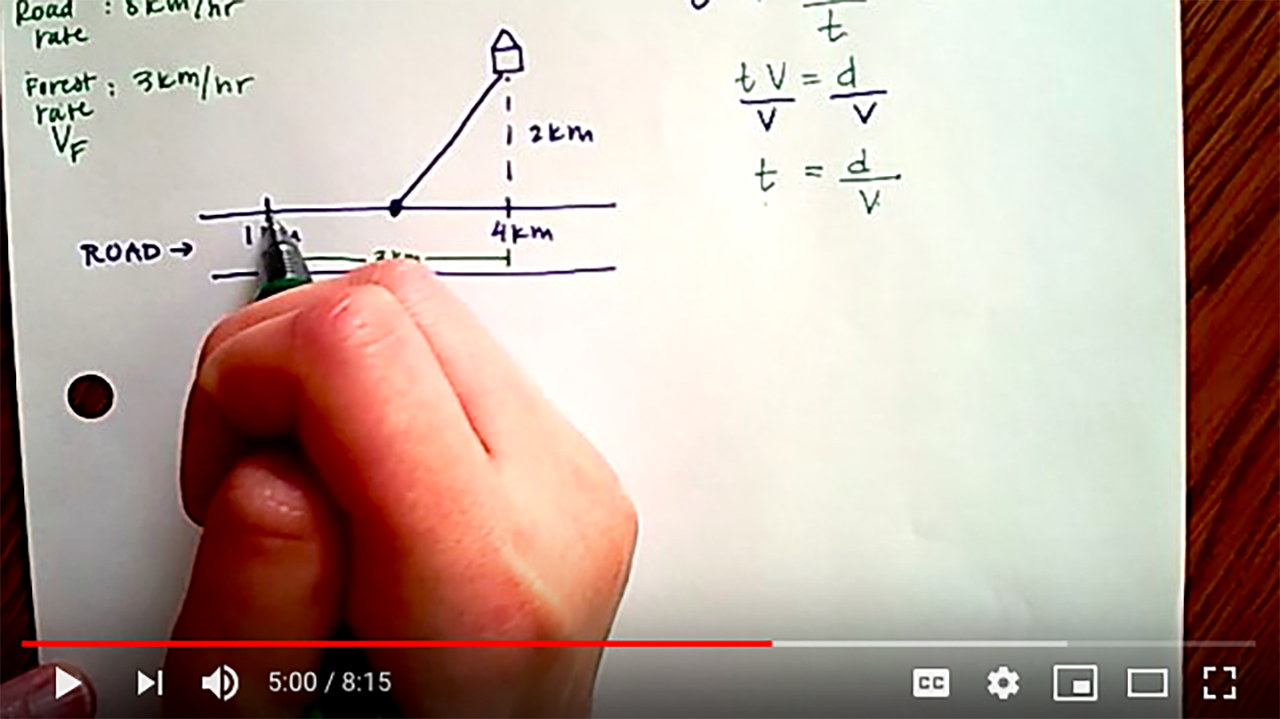Inherent in teaching math is a tension between breadth and depth—covering all curricular topics in a given course often comes at the expense of engaging students in rich problem solving and mathematical thinking (a.k.a. the fun stuff). This year in my Calculus Core class I’ve managed to spend more class time on the fun stuff by implementing a “flipped classroom.”
What the flip?
In a traditional math classroom, a teacher introduces new material through notes in class, then assigns practice problems at home. The Flipped Classroom reverses the location of these two activities: students watch videos and take notes for homework, freeing up more class time for exploration, practice, and problem solving.
About once a week, I create a video “lecture” introducing a new topic and assign it for homework. I try not to make videos longer than 20 minutes, and I’ve found my students’ attention starts waning if my videos are longer than 15 minutes. Students are responsible for watching the video and completing any “You Try” problems I include (usually one or two problems). Students report spending about 30 minutes on video notes.
This year has been a learning experience for me, but I’ve found the benefits wider-reaching than I anticipated. Not only have I minimized the breadth vs depth dilemma, but my students report feeling more successful at tackling difficult problems and less stressed about the pace of learning.
You Heard it from the Students
I recently talked with my students about what they like and don’t like about this classroom model and, spoiler alert, there’s not much they don’t like.
Coming into class after taking video notes for homework, students feel more prepared for what comes next. “You go into class and you’ve already seen everything once,” says senior Dylan McAfee, “so it makes it easier to learn the material.”
Senior Jordyn Lemer appreciates the extra time to let the content sink in: “It’s able to sit with me overnight and then I get to class and ask [the teacher] questions… Sometimes when we take notes in class and then go straight into problems it’s a little hard to process.”
Taking notes from a video also gives students more flexibility to move at their own speed.
“I don’t have to rush and I can go back and pause it,” says senior Nina DeCola. “If I don’t understand something I can watch it again.” Nina finds that her notes are better organized when she takes them from a video. Videos also remain on my YouTube channel, which Nina says she references when studying for tests and quizzes.
Every student learns at a different pace, and in a classroom setting, this can make a student feel self-conscious or stressed as they may compare themselves to other students. “In other years, there’s always one person—and it’s not a bad thing—that needs more time for stuff and there’s always one person who’s way ahead. I’ve been both those people before,” reflects senior Shonali Palacios. “But either way, the pace is very stressful because it’s either you’re bored and sitting there waiting for a problem, or you’re like, ‘Wait, what’s happening? Can we slow down?’ and then feeling bad about dragging the rest of the class down.”
Flipping the classroom helps both types of students Shonali describes, as it allows a teacher to more easily differentiate their instruction. The class held after a video, some students may be ready to dive into a problem set, while others may come in with questions or confusion. With notes out of the way, I can clarify points of confusion for some, without slowing down those who feel ready to apply what they are understanding.
The Fun Stuff
What I call the “fun stuff,” my students call the “hard stuff.” But they appreciate the time and space to engage in this type of problem solving in class instead of at home, as they feel more supported and therefore more successful. “We do more challenging problems in class and I can actually finish them because I have help,” says Shonali.
“Class time feels more efficient because it’s more collaborative and we’re working through problems that we wouldn’t have been able to do on our own,” says junior Amelia Myre. “When we have questions about actually doing problems…we can ask in class, whereas if we were doing problems on our own at home, sometimes we’d get stuck and not be able to finish.”
In this context, the teacher’s role shifts from instructor to facilitator, and students’ problem solving and mathematical thinking take center stage. “When we’re here, it’s us doing the work and using each other to learn, rather than the teacher doing all the work for us,” says senior Brion Whyte.
Pedagogically the idea of flipping makes sense in the context of Bloom’s Taxonomy. This frequently referenced hierarchy of cognitive skills goes from lower to higher order thinking skills, starting with knowledge and comprehension, and building up to application, analysis, synthesis, and evaluation. As teachers, why should we spend valuable class time on knowledge and comprehension when students can more easily do these types of thinking independently?
Are you a teacher? Give flipping a try!
To all those teachers out there feeling inspired but logistically skeptical, let me assuage your fears. Using the recording device on my document camera, I am able to easily record videos of me writing out notes and examples while I narrate. The camera records my hand not my face, for which I am grateful! I believe making your own videos is essential, as opposed to sourcing videos online; you are the teacher your students know and trust, not Sal from Khan Academy. My videos are not polished or edited, a bell may go off in the middle and sometimes I even make mistakes in the math—good thing I’m always telling my students mistakes are valuable!
I like to use the class held before a video to allow students to explore a new topic and build their own understanding. Then in the video, their ideas are formalized and example problems are introduced. The next class, students have an opportunity to ask questions and practice the concept in groups and independently. Since I haven’t spent a period giving notes, I don’t feel the time crunch inherent in the breadth vs depth dilemma, and I’m freed up to spend another day (or more!) delving into more challenging problems. Flipping is easier than you might think and, according to my students, makes a world of difference in their ability to learn and do mathematics.



